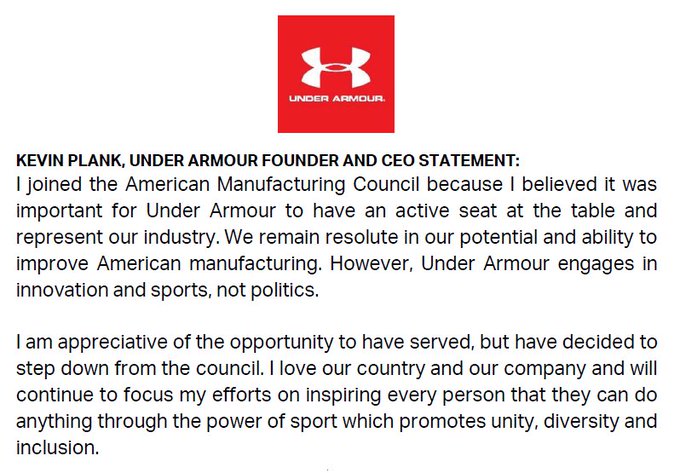 Trump was supposed to be the businessman president. He was supposed to run the federal government more like the private sector. The real estate mogul turned president filled his Cabinet with a cadre of Wall Street and corporate bigwigs and invited top CEOs to join two White House business councils, the Strategic and Policy Forum and the American Manufacturing Council.
Trump was supposed to be the businessman president. He was supposed to run the federal government more like the private sector. The real estate mogul turned president filled his Cabinet with a cadre of Wall Street and corporate bigwigs and invited top CEOs to join two White House business councils, the Strategic and Policy Forum and the American Manufacturing Council.
Wednesday afternoon, as CEOs withdrew from the councils en masse and Trump disbanded them, it all fell apart.
Initially, the prospect of playing a role in deregulating Wall Street and slashing corporate taxes must have thrilled many business leaders. But as each month in the new administration passed, public pressure to disassociate from the administration mounted. Consumers and social justice advocates launched aggressive media campaigns to get CEOs to quit the councils. Any connection to the president started to turn into a liability.
The defections from Trump’s two business councils started slowly after the president’s so-called Muslim ban and intensified after his withdrawal from the Paris climate agreement. This week was a turning point, after Trump’s tepid condemnation of white supremacists who killed a woman in Charlottesville, Virginia, over the weekend. By Wednesday, the president’s Strategic and Policy Forum and American Manufacturing Council had disbanded.
Public outrage had proved too overwhelming.
“We believe the debate over Forum participation has become a distraction from our well-intentioned and sincere desire to aid vital policy discussions on how to improve the lives of everyday Americans,” participants said in a statement explaining their decision. “As such, the president and we are disbanding the Forum.”
What was the point of the councils anyway?
Trump’s two main business councils were supposed to give him advice on policies that could help grow the economy and create new jobs. It’s something most presidents do to get input from business leaders outside of Washington.
President Barack Obama, for example, formed the President’s Council on Jobs and Competitiveness. It was filled with the CEOs from some of the same companies that Trump invited to his own councils, including the head of Boeing and Ford Motor Company. Obama’s council ended up holding five meetings and more than a dozen “listening sessions” with local businesses across the country. They came up with 35 specificrecommendations, and the administration implemented about half of them (including an executive order to cut wasteful government spending).
Trump’s councils were supposed to have a similar goal. Shortly after his election, Trump announced his own group of business advisers, called the President’s Strategic and Policy Forum. The group was led by Stephen Schwarzman, CEO of the investment firm Blackstone. At the time of the announcement, Trump’s transition team said the business leaders would be “called upon to meet with the president frequently to share their specific experience and knowledge as the president implements his plan to bring back jobs and make America great again.”
But Trump want even further, creating the American Manufacturing Council too. The intention was for the CEOs of US manufacturing giants to help him fulfill his campaign promise to bring factory jobs roaring back to life in the Rust Belt. The group included the leaders of General Electric, Campbell Soup, and Under Armour.
So far, Trump’s business councils haven’t done much. He’s only met with each group once at the White House — back in February. At his February 3 meeting with the forum, Trump promised business leaders an exciting future with tax reform and health reform on the near horizon. He even promised to meet on a monthly or quarterly basis with the CEOs.
“We’re bringing back jobs, we’re bringing down your taxes, we’re getting rid of your regulations, and there are some really exciting times ahead,” Trump told the group, according to Business Insider.
At his February 23 meeting with the American Manufacturing Council, Trump told executives he would bring millions of manufacturing jobs back to the United States and would crack down on the $60 billion trade deficit with Mexico.
After the group discussion, participants broke out into four working groups: tax and trade, regulatory reform, infrastructure, and workforce issues.
That’s about it.
Quitting the council became a way for CEOs to take a stand
Seats on presidential business councils are highly coveted. After all, they give business leaders some input in shaping public policy. But under the Trump administration, these roles quickly became a liability — and quitting the councils became a high-profile way for CEOs to make a statement about their corporate values.
A week after taking office, Trump signed an executive order banning visitors and refugees from seven Muslim-majority countries. Outrage and chaos ensued. Taxi drivers at JFK Airport in New York went on strike, and then-Uber CEO Travis Kalanick drew public ire for allowing Uber drivers to break the strike. A #DeleteUber hashtag went viral, and racial justice groups, such as Color of Change, launched a #QuitTheCouncil campaign to pressure business leaders to step up to Trump.
The day before the business forum’s one and only meeting at the White House, Kalanick resigned.
“Joining the group was not meant to be an endorsement of the President or his agenda but unfortunately it has been misinterpreted to be exactly that,” he wrote in a staff memo. “There are many ways we will continue to advocate for just change on immigration but staying on the council was going to get in the way of that.”
A few months later, President Trump announced plans to withdraw the United States from the Paris climate agreement. That sparked fierce resistance from corporate America, which had been making strides to reduce its carbon footprint.
SpaceX and Tesla CEO Elon Musk threatened to leave the business forum if Trump pulled out of the agreement. Trump did, and Musk left:
A few hours later, so did the CEO of Disney:
The breaking point came in August, after violence at a white supremacist rally in Charlottesville ended up killing a young counterprotester. Instead of calling out the neo-Nazis by name, Trump condemned the violence “on all sides.”
Resignations from Trump’s manufacturing council started to come in. First was Monday’s departure of Kenneth Frazier, the CEO of the pharmaceutical giant Merck.
Frazier, who is African American, criticized Trump for not “clearly rejecting expressions of hatred, bigotry and group supremacy.”
Then Brian Krzanich, the CEO of Intel, did the same:
It may have stopped there, considering Trump later gave a more forceful condemnation of the white supremacist groups. But Tuesday afternoon, at an impromptu press conference, Trump went back to blaming both sides for the violence.
Business leaders got on the phone and decided they could not longer work with the president. The public pressure was too much. Reportedly, when they told the administration about their plans to disband, Trump tried to fire them first:
In the end, advising the president became a public relations nightmare for corporate leaders, and that overshadowed any benefit they saw in keeping a seat on one of his councils.
What this means going forward
The businessman president has lost the public support of the most influential players in the business community. But the story doesn’t have to end there. Business leaders have a choice: They can band together and push Trump to abandon the policies they have denounced, or they can just stop with their symbolic distancing from the president.
It’s unlikely that business leaders will do much more, considering they still have a major stake in the president’s agenda. More than anything, they are counting on him to slash corporate taxes and ease business regulations.
The US Chamber of Commerce’s silence on the latest controversy is one indication that the business community doesn’t want to do too much to disrupt the administration. As outrage over the events in Virginia intensified, the chamber was busy tweeting about the need to act on tax reform.
[“Source-vox”]


